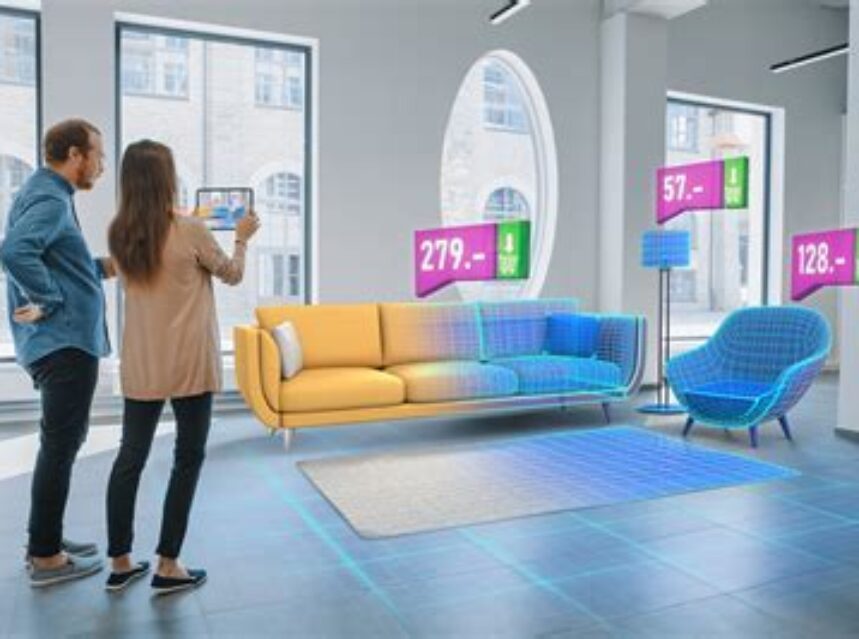The Future of Augmented Reality in Retail Marketing

Stay ahead with AR in retail – learn integration strategies, customer experience enhancement, and measuring ROI for effective marketing. Discover emerging trends and impact on consumer behavior.Augmented reality (AR) technology has been making waves in the retail industry, offering innovative ways to engage and captivate customers. As the retail landscape continues to evolve, it’s important for businesses to stay ahead of the curve and embrace emerging trends in AR retail. This blog post will delve into the future of augmented reality in retail marketing, exploring key subheadings such as emerging trends in AR retail, integration strategies for AR deployment, enhancing customer experience with AR, AR impact on consumer behavior, and measuring AR ROI in retail marketing.
From interactive product displays to virtual try-on experiences, AR has the potential to revolutionize the way consumers shop and interact with brands. By understanding the impact of AR on consumer behavior and learning how to effectively integrate AR into retail marketing strategies, businesses can enhance the overall shopping experience and drive measurable results. Join us as we explore the exciting possibilities and practical applications of AR in retail marketing.
Emerging Trends in AR Retail
Augmented Reality (AR) technology is rapidly transforming the retail industry, offering immersive and interactive experiences for customers. One of the emerging trends in AR retail is the use of virtual try-on technology, allowing shoppers to see how clothing or accessories look on them without physically trying them on. This not only enhances the customer experience but also reduces the need for physical inventory, leading to cost savings for retailers.
Another trend is the integration of AR-enabled shopping assistants in brick-and-mortar stores, providing personalized product recommendations and guided tours of the store. This not only enhances the in-store experience but also increases customer engagement and ultimately drives sales. Furthermore, the use of AR-powered visual search is gaining momentum in retail, enabling customers to search for products by simply pointing their smartphone camera at an item. This simplifies the search process and provides a more efficient shopping experience.
AR is also impacting the way retail businesses market their products, with the use of AR-powered advertisements and interactive displays. Retailers are leveraging AR to create memorable and shareable experiences for customers, driving brand engagement and loyalty. Additionally, the measurement of AR ROI in retail marketing is becoming increasingly important, as retailers seek to understand the impact of their AR initiatives on customer behavior and sales.
As AR continues to evolve, it is clear that it will play a significant role in shaping the future of retail, offering innovative solutions to enhance the customer experience, drive sales, and differentiate brands in a competitive market.
Integration Strategies for AR Deployment
Augmented Reality (AR) is revolutionizing the way businesses engage with their customers, and integrating this technology into retail operations requires careful planning and strategic deployment. One of the key integration strategies for AR deployment is to focus on seamless user experience. Retailers should ensure that the AR features are integrated into the existing mobile apps or websites in a way that enhances rather than disrupts the customer journey.
Another important integration strategy is to leverage existing data and analytics infrastructure. By integrating AR into the retail analytics platform, businesses can track and measure the impact of AR on customer engagement, conversion rates, and overall sales performance. This data-driven approach allows retailers to assess the effectiveness of AR deployment and make informed decisions about future integration strategies.
Moreover, collaboration with technology partners and AR solution providers is essential for successful integration. Retailers should seek out partnerships with AR developers and vendors to ensure compatibility, scalability, and technical support. Working closely with these partners can help businesses navigate the complexities of AR integration and develop customized solutions that align with their brand identity and customer preferences.
Lastly, it is crucial for retailers to provide comprehensive training and support to their employees. Integrating AR into retail operations often requires employees to adapt to new tools and processes. By investing in training programs and offering ongoing support, businesses can ensure that their staff are equipped with the necessary skills to effectively deploy and manage AR technologies in the retail environment.
Enhancing Customer Experience with AR
Augmented Reality (AR) has taken the retail industry by storm, revolutionizing the way businesses interact with their customers. The integration of AR technology in retail has proven to be a game-changer in enhancing customer experience. By leveraging AR, retailers can offer a more immersive and personalized shopping experience, allowing customers to interact with products in a whole new way.
One of the key benefits of AR in enhancing customer experience is the ability to provide virtual try-on experiences. Customers can now visualize how a product will look or fit before making a purchase, reducing the need for returns and improving overall satisfaction. This not only enhances the customer’s shopping journey but also boosts their confidence in the products they are buying.
Moreover, AR can also be used to offer additional product information and recommendations through interactive displays. This not only helps customers make more informed purchasing decisions but also creates a sense of engagement and excitement, ultimately leading to a more enjoyable shopping experience.
Furthermore, AR-powered mobile apps can enhance the in-store experience by providing personalized content, special offers, and interactive features that add value to the customer’s visit. By leveraging AR technology, retailers can build stronger connections with their customers and create memorable experiences that keep them coming back for more.
AR Impact on Consumer Behavior
Augmented Reality (AR) technology has been making waves in the retail industry, and its impact on consumer behavior is undeniable. With the use of AR, retailers are able to provide a more immersive and interactive shopping experience for their customers. This technology allows consumers to visualize products in their own space, try on virtual clothing, and even see how furniture would look in their homes before making a purchase. Such enhanced visualization not only increases customer engagement but also influences their purchasing decisions.
Furthermore, the introduction of AR in retail has changed the way consumers interact with brands. It has shifted the focus from passive consumption to active participation, where customers are involved in the product experience. This heightened engagement leads to a sense of personal connection with the brand, thereby influencing consumer loyalty and repeat purchases.
Another significant impact of AR on consumer behavior is the element of convenience it offers. By using AR technology, shoppers can streamline their decision-making process by virtually trying out multiple options without physically having to visit different stores. This convenience factor plays a vital role in shaping consumer preferences and shopping habits.
Moreover, AR has the potential to create a sense of exclusivity and uniqueness for shoppers. The ability to customize and personalize products through AR experiences can make consumers feel special and valued, prompting them to make purchases they perceive as one-of-a-kind.
Measuring AR ROI in Retail Marketing
Augmented Reality (AR) has become an increasingly popular tool for retail marketing in recent years, with many companies investing in AR technology to enhance their customers’ shopping experience. With this growing trend, it is important for retailers to measure the Return on Investment (ROI) of their AR initiatives to ensure they are making the most of their resources.
One way to measure the ROI of AR in retail marketing is to track the increase in sales and overall revenue after implementing AR features in stores or online. By comparing sales data before and after the introduction of AR technology, retailers can determine whether the investment in AR has led to a significant boost in sales and revenue.
Another important metric to consider when measuring the ROI of AR in retail marketing is the impact on customer engagement and satisfaction. Retailers can analyze customer feedback, time spent interacting with AR content, and other relevant data to assess the impact of AR on customer experience. Higher levels of engagement and satisfaction can indicate a positive ROI for AR initiatives.
Furthermore, retailers can also consider the cost savings and efficiency gains resulting from the use of AR technology in marketing. For example, AR can streamline the product visualization process, reducing the need for physical store displays and samples. By quantifying the cost savings and efficiency gains, retailers can better understand the overall impact of AR on their bottom line.



